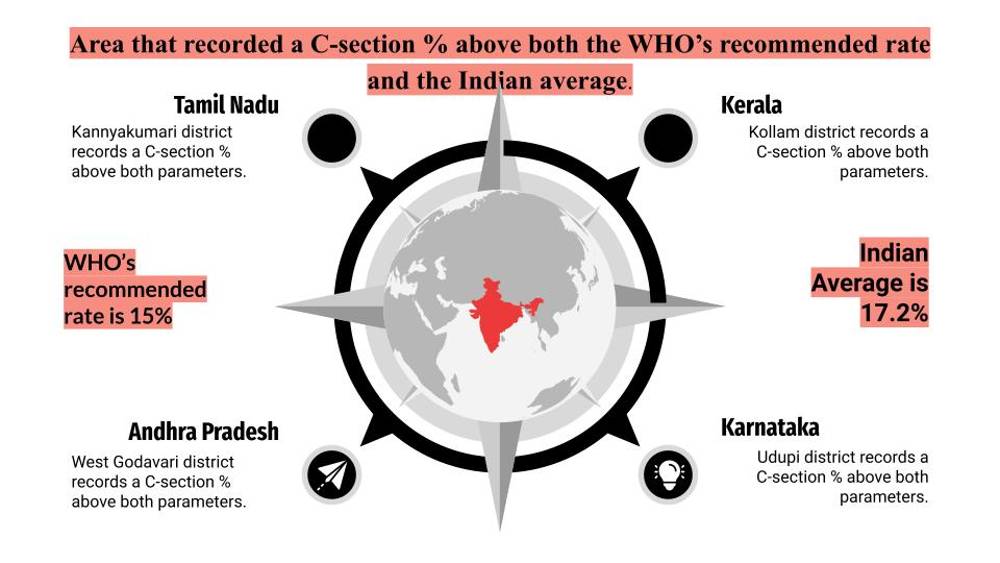There are 18,463 more caesarean births as compared to natural births in private institutes in urban areas.
The number of Caesarean (C-section) births have overtaken the number of normal births in 2020 in private and non-governmental institutes in urban areas in Karnataka.
In 2020 the number of registered natural births in private and other non-government institutes were 1, 77,516. The number of C-sections in the same category were 1, 95,979 births. On the other hand, government hospitals reported more natural births. Government hospitals in urban Karnataka had 3, 41,174 natural births and 1, 31,821 C-section births shows the Annual Report on The Registration of Births and Deaths Act, 1969 by the Directorate of Economics and Statistics Karnataka, Bengaluru.

Live births by method of delivery and type of institution
C-section rates rose across the globe, from seven percent of all births in 1990 to 21 per cent last year, a World Health Organisation (WHO) study found. It also estimated that by 2030 one out of every three births will be by C-section bringing the total estimated C-section rate to 29 per cent. WHO issued recommendations for non-clinical interventions to reduce unnecessary caesarean sections.
Dr. Roopa who works at a private hospital, said, “Most expecting mothers want a C-section these days primarily because they plan the birth. They do not want to endure the pain and wait for a long time in labour.” She added that most expecting mothers are educated by their staff about the benefits of a natural birth and are urged to avoid major surgery unless it is justified for health reasons.

The charts at the private hospital Dr. Roopa works at show that they deliver 35,000 babies via natural birth and 45,000 through Lower Segment Caesarean Section (LSCS) every year. “The kind of birth depends mostly on the condition of the baby and the mother, the position of the baby as it can be upside down sometimes or it can be a big baby and also when there is an issue with the placenta. Any indication that there could be an unwarranted problem is when we suggest C-section otherwise we always suggest normal vaginal birth. It is up to the mother and the family ultimately to decide we can only guide them,” said Dr. Roopa.
From online reviews of a government hospital, patients say that they are guided in the right way as to what is the better course based on the situation of the mother and baby. A new mother who had a healthy baby boy from a government maternity institute also said that her doctor assured her that she would deliver naturally and even after an issue with baby came up she delivered naturally. Ramesh (name changed), a new father said, “C-sections are more expensive so private hospitals do more of those and government hospitals do less of it as they offer free services, so they prefer normal deliveries.”
Lakshmi, mother of two said as her first child was stillborn, she was closely monitored by her doctors for her second pregnancy and she naturally delivered a healthy baby girl after about 37 weeks. The next time there were complications with the position of the baby as the umbilical cord was tightly wrapped around the baby’s neck, doctors prepared for a C-section but just before performing the surgery she was asked if she would like to push and try for a natural birth. She agreed and delivered her second healthy child that day.
Sashi, a new mother of twins said, “I was so happy when I found out I was having twins, the doctor suggested that C-section would be better as normal birth with twins might be harder and more painful.” She said that she was hoping for a natural birth as growing up she had always heard that if the first pregnancy is a C-section then natural birth is not usually an option for the next ones. She added, “A far off relative of mine who also had twins knew her doctor well had a closely monitored natural birth, my C-section could have been avoided I think.”
Tanya, a student with an MD in gynaecology said, “There are many absolute indications that decide if we have to go ahead with a c-section like the small size of the pelvis, size of the baby or position of the baby.” She also added that in rural areas the people who get pregnant are usually around 20 years and below so they have a small pelvis and in case where the mother is above 35, the complication rate is high in both kinds of cases a C-sections has to be done. She also added “Many patients are opting for a C-section these days as they think it is painless and more efficient but that is not always true which why people need to be educated about this, that can reduce these numbers.”





Good analysis. Many private hospitals suggest for a C- section as it is money earning.
It has been long suspected that private hospitals do promote CS for making quick bucks. Now the author has proved so with in-depth analysis with facts and figures. Congratulations to Surabhi for bringing out one of the dark sides of private hospitals.